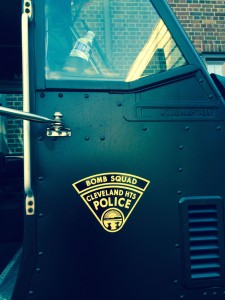 I had every intention of wrapping up my experience with the Cleveland Heights Citizens Police Academy back when it ended last fall. But I didn’t know what to say.
I had every intention of wrapping up my experience with the Cleveland Heights Citizens Police Academy back when it ended last fall. But I didn’t know what to say.
That is until a Cleveland Heights resident named Samuel Taylor allegedly led police on a brief car chase through a residential neighborhood here. Then, after he reportedly stopped his car and ran in the police officer’s direction, he took great umbrage that the police officer briefly drew his gun while sizing up the situation.
The incident occurred three weeks after Tamir Rice was killed by a Cleveland police officer, and the bulletin board at Cleveland.com was still afire with comments that the boy brought the shooting on himself by failing to follow police instructions.
Taylor’s story lit up the bulletin board again with some people writing that the officer never should have raised his weapon when a white-skinned man in the suburbs made the same mistake that turned out to be a death sentence for a 12-year-old black kid in the ‘hood.
I’m not going to rehash the incident further; you can read all about it here and here and here.
But I bring it up because it says something about the relationship between the community and the CHPD.
- We expect our police to prevent crime, solve crime and discourage incursions by criminals from other communities. But we also expect them to be warm, friendly and non-menacing.
- We embrace our diversity but believe police officers should know at an instant – and even bet their lives on it – whether a fleeing suspect is a bad guy or a library-card-carrying middle-class home-owner.
- We want idyllic, safe, tree-lined streets, but we resent aggressive traffic enforcement that deters speeders, drunk drivers, drug traffickers and itinerant thugs.
- We want urban chic but small-town policing.
We think of Cleveland Heights as a small place, but with 45,000 residents it’s the largest city on the East Side except for Euclid (48,000). It’s Ohio’s 24th-largest city – way bigger than Massillon, Kent, Wooster and Sandusky, to name a few places we think of as significant urban areas. Also much larger than Shaker Heights (27,900), South Euclid (22,000) and Beachwood (11,900).
So what we really seem to want is Andy Taylor to keep the peace in Gotham.
That’s not possible, and it may be that the biggest problem we have with the CHPD is our own expectation.
City Hall bears some responsibility for that. For years, from the police chief to the city manager to the mayor and other members of city council, there wasn’t much appetite to engage citizens with the harsh realities of policing Cleveland Heights. As the environment was changing, they were OK if the rest of us went on thinking we were living in Mayberry.
But that’s changed. All of the key positions have turned over in the last few years. Since becoming police chief in 2011, Jeffrey Robertson has opened several doors and windows to the community – Facebook, Twitter, Thursday evening Meet the Police open houses, publication of current crime data and the new Citizens Police Academy.
This city’s police department has never worked with more transparency than it does today, and more is coming; before 2015 is over, every officer on the street will be equipped with a body camera.
If all of that still isn’t enough, residents need to provide some direction on what else we expect from our city and our public safety force. The police department is looking to create better connections with the community for improved trust, confidence and understanding. Rather than just complain or live with a sense that something is wrong, the populace needs to show up for the conversation too.
Before my experience at the Citizens Police Academy, I had a few big concerns about the way we manage public safety in Cleveland Heights – like the idea that police are too busy writing parking tickets to mind the muggers and copper thieves. (If you scroll through some of my older posts here, you’ll find more about them.)
But after my experience, I have a clearer sense of where policing ends and governing takes over. I realize some of our gripes – parking tickets as a prime example – are really policy issues that need to be addressed through public participation and good governing.
I also realize our police department does a better job than many residents imagine. If an officer appears to you as too aggressive or somewhat threatening, that’s the way he likely appears to bad guys too. And having spent 40 hours with the police department over eight weeks last fall, I know now that they deal with a lot more bad guys than I ever thought possible.
That’s not to say the CHPD is perfect. It has more than 100 officers and I’m sure legitimate grievances arise regularly.
But I also know that the worst crimes we had last year were solved within days or even hours. And I’m sure many other crimes never occurred exactly because of the way our police officers carry themselves.
And Samuel Taylor walked away from his incident with nothing worse than a bruised ego and a couple of citations. In another city, he might be dead.
As residents, if we want to be more satisfied with the our police department, we need to understand it better. That’s why I signed up for the Citizens Police Academy, and I’m glad I did.
A second Cleveland Heights Citizens Police Academy will be held sometime during 2015 with participants selected through a brief application process. Look to the Heights Observer and and the CHPD website for more information as it becomes available.



Leave a Reply